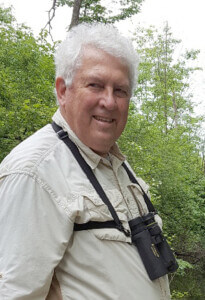RANGER STEVE’S NATURE NICHE
Flashing Fireflies
By Ranger Steve Mueller
 It was a dark night with a hidden moon. During that special time, the moon and the sun are on the same side of the Earth. It is a time the moon is nowhere to be seen and is a miraculous time to enjoy the blackness of night.
It was a dark night with a hidden moon. During that special time, the moon and the sun are on the same side of the Earth. It is a time the moon is nowhere to be seen and is a miraculous time to enjoy the blackness of night.
From the back porch instead of thinking about the moon, fireflies captured my attention. I drifted to my childhood, the time when my kids were young, and now with anticipation for exploring flashing lightning bugs with grandsons. Fireflies and lightning bugs are neither flies nor bugs. They are beetles with hard wing covers they pull forward to expose membranous wings for flight. The wing covers, called elytra, are dark with orange markings but they are not seen at night. What excites us in the dark is their flashing of green, yellow, or red.
With dusk diming on warm nights, a firefly light show begins. I enjoy their fireworks more than the beautiful noisy fireworks we set off from cannons. For me, human fireworks are best enjoyed from a distance where their explosions do not ruffle my senses like the bombs of war. Fireflies blink silently to attract mates. While they are busy searching for one with whom to make love, I count flash frequency. Each species has a unique flash speed that speaks like Morse code. They do not talk in words but signal with light codes.
My mind drifts to a favorite “Sesame Street” character—the Count. He loved to count. With my kids we counted the flashes of these night insects. We would count how many were flying. In darkness they would disappear but we would try to determine their direction of flight. It was a wonderful way to explore the outdoor world.
As a child, sitting and watching was more than could be tolerated. Chasing and capturing them in a jar was essential. I recall on a boy scout camping trip some of the scouts felt it necessary to catch many. Once they had a large number in a jar, they had to determine what to do with them. That was a temporary dilemma. My dad was a scoutmaster and they thought it would be fun to release them in his tent. When he left the campfire to go to bed he would discover his sleeping bag full of burning coals or so he would think. What fun for the scouts!
There is a festival at Great Smokey Mountain National Park in May that attracts people from great distances to see the synchronized flashing. It is not necessary to travel far. The show occurs locally from early June through July. Urban yards might not be a suitable stage but an evening drive with kids or grandkids can be rewarding.
Fireflies need fields and forests near marshes or damps areas. They are declining worldwide for various reasons not completely understood. Some things are known. They do not move to nearby habitats when human development expands to replace their home. They simply die a local extinction. Our continuously growing population is pushing them off the Earth. Stabilizing our population to share creation will help other species survive. Beside habitat loss, light pollution from too much yard light along with use of pesticides and herbicides are causing declines. We can provide creation care for fireflies for their sake or for our own.
Scientists found firefly luciferase that produces the bioluminescence can be used as a marker to detect blood clots. It helps identify tuberculosis virus cells. It aids the monitoring of hydrogenperoxide levels that identify cancer and diabetes. We might think nature is expendable with no consequences for us but it is not. We needed to collect the beetles for their chemical but have learned to synthesis it. We would not know its benefits without these insects. If we let other species disappear, we will never discover their value when a need arises. Maybe a cure for coronavirus or other new diseases is hidden in plants or animals but will disappear with the massive extinctions of life forms that is occurring.
Protect fields, forests and marshes. Fireflies thrive as larvae in rotting wood and forest leaf litter at the margins of ponds and streams. This is a good year for them with the rain we received. Avoid over cleaning yards and gardens. Immaculate yards spell death to this valuable community member. They help us by feeding on slugs and snails. Avoid using pesticides and herbicides in yards and gardens. Fireflies hide by day in lawns and wild portions of the yard. Incorporate taller grasses in your landscaping. Look at yards with fireflies and determine how they differ from those without.
Firefly flashes make them a charismatic species and their declining abundance is eliminating a great joy in life. They call public attentionwith their rapid response to environmental changes. They are a good bioindicator identifying mismanagement of the world for which we should take care responsibility.
Natural history questions or topic suggestions can be directed to Ranger Steve (Mueller) at [email protected]
Ody Brook Nature Sanctuary, 13010 Northland Dr. Cedar Springs, MI 49319 or call 616-696-1753.
Written for WORC e-News July 2020

Download Conserving the Jewels of the Night PDF booklet


Firefly Conservation: A Guide to Protecting the Jewels of the Night is a new pamphlet from the Xerces Society. “By carefully considering the needs of fireflies and how our actions could affect these animals, we can take steps to ensure that their lights continue to shine for future generations.”
Learn more about fireflies at the Xerces Society.
